Experimental Analysis of the Influence of Heat Treatments on the Flexibility of NiTi Alloy for Endodontic Instruments Manufacturing
Abstract
1. Introduction
2. Materials and Methods
2.1. Sample Selection
2.2. Statistical Design of Experiment
- −
- Y1: Maximum bending moment: the value of the torque (bending moment) when the bending rotation is maximum (45°) during the last loading cycle (bending tests are described later in this document).
- −
- Y2: The size of the hysteresis: the difference between the bending moment measured during loading and unloading of the last cycle at two thirds of the maximum applied rotation (45°).
- −
- Y3: Stiffness during martensitic transformation (transformation slope): the slope coefficient of the transformation domain in the moment-rotation diagram, chosen between a first point positioned at one third of maximum rotation and a second point positioned at two thirds of maximum rotation.
2.3. Heat Treatment
2.4. Bending Test
2.5. Statistical Analysis
- −
- the complete model (u1, u2, u3, u1*u2, u1*u3, u2*u3, u1*u2*u3). This model is the complete linear one with simple factor effects, quadratic effects, and interaction effects up to order 3.
- −
- The following sub-models were applied:
- −
- model with simple effects, and interaction effects of order 2 (u1, u2, u3, u1*u2, u1*u3 and u2*u3);
- −
- model with only the simple effects (u1, u2, u3);
- −
- complete model by removing u3 (u1, u2, u1*u2);
- −
- complete model by removing u2 (u1, u3, u1*u3);
- −
- complete model by removing u1 (u2, u3, u2*u3);
- −
- model with only the effect of u1 (u1);
- −
- model with only the effect of u2 (u2);
- −
- model with only the effect of u3 (u3).
3. Results
3.1. Exploratory Analysis
3.2. Statistical Analysis
- −
- For Y1 (Maximum bending moment): the only interaction that exists in this DoE is between temperature and holding time. u1 (temperature in °C) is the most critical factor for Y1 (N.mm). It explains more than 85% of the variability of the response without even considering the interaction effect with u2 (holding time in min). This R2 of more than 85% shows that the model is effective at predicting the relationship between contributing factors and the response Y1. u2 also has an impact on Y1 through the interaction effect with u1. Finally, the cooling method (u3) is not a critical factor for Y1.
- −
- For Y2 (Hysteresis size): the simple effect of u1 is critical for Y2 followed by the simple effect of u2. More than 71% of the variability is explained only by the effect of u1 and almost 18% by the simple effect of u2. The other effects are not significant.
- −
- For Y3 (Stiffness during martensitic transformation): the complete model explains 62.5% of the variability for Y3. The most critical effect is the interaction effect between u1, u2, and Y3. There is also a simple effect of u2. In fact, looking at the R2 of model 4, we can see that 57% of the variability comes from simple and interaction effects of u1 and u2. The third factor u3 is not significant.
4. Discussion
5. Conclusions
Author Contributions
Funding
Institutional Review Board Statement
Informed Consent Statement
Data Availability Statement
Acknowledgments
Conflicts of Interest
References
- Thompson, S.A. An overview of nickel-titanium alloys used in dentistry. Int. Endod. J. 2000, 33, 297–310. [Google Scholar] [CrossRef]
- Anil, S.; Neelakantan, P.; Nassif, W. Evolution of Nickel–titanium Alloys in Endodontics. J Contemp. Dent. Pract. 2017, 18, 1090–1096. [Google Scholar] [CrossRef] [PubMed]
- Tabassum, S.; Zafar, K.; Umer, F. NiTi Rotary Systems: What’s New. Eur. Endod. J. 2019, 3, 111–117. [Google Scholar] [CrossRef]
- Nematollahi, M.; Baghbaderani, K.S.; Amerinatanzi, A.; Zamanian, H.; Elahinia, M. Application of NiTi in Assistive and Rehabilitation Devices: A Review. Bioengineering 2019, 6, 37. [Google Scholar] [CrossRef]
- Zanza, A.; D’Angelo, M.; Reda, R.; Gambarini, G.; Testarelli, L.; Nardo, D.D. An Update on Nickel-Titanium Rotary Instruments in Endodontics: Mechanical Characteristics, Testing and Future Perspective—An Overview. Bioengineering. 2021, 8, 218. [Google Scholar] [CrossRef]
- Sattapan, B.; Palamara, J.E.; Messer, H.H. Torque During Canal Instrumentation Using Rotary Nickel-Titanium Files. J. Endod. 2000, 26, 156–160. [Google Scholar] [CrossRef] [PubMed]
- Gambarini, G.; Cicconetti, A.; Di Nardo, D.; Miccoli, G.; Zanza, A.; Testarelli, L.; Seracchiani, M. Influence of Different Heat Treatments on Torsional and Cyclic Fatigue Resistance of Nickel–Titanium Rotary Files: A Comparative Study. Appl. Sci. 2020, 10, 5604. [Google Scholar] [CrossRef]
- Gavini, G.; Dos Santos, M.; Caldeira, C.L.; Machado, M.E.D.L.; Freire, L.G.; Iglecias, E.F.; Peters, O.; Candeiro, G. Nickel–titanium instruments in endodontics: A concise review of the state of the art. Braz. Oral Res. 2018, 32, 44–65. [Google Scholar] [CrossRef]
- Hou, X.-M.; Yang, Y.-J.; Qian, J. Phase transformation behaviors and mechanical properties of NiTi endodontic files after gold heat treatment and blue heat treatment. J. Oral Sci. 2020, 63, 8–13. [Google Scholar] [CrossRef] [PubMed]
- Vincent, M.; Hartemann, P.; Engels-Deutsch, M. Antimicrobial applications of copper. Int. J. Hyg. Environ. Health 2016, 219, 585–591. [Google Scholar] [CrossRef]
- Vincent, M.; Xolin, P.; Gevrey, A.M.; Thiebaud, F.; Engels-Deutsch, M.; Ben Zineb, T. Experimental and numerical analysis of penetration/removal response of endodontic instrument made of single crystal Cu-based SMA: Comparison with NiTi SMA instruments. Smart. Mater. Struct. 2017, 26, 045014. [Google Scholar] [CrossRef]
- Xolin, P.; Collard, C.; Engels-Deutsch, M.; Zineb, T.B. Finite element and experimental structural analysis of endodontic rotary file made of Cu-based single crystal SMA considering a micromechanical behavior model. Int. J. Solids. Struct. 2021, 221, 180–196. [Google Scholar] [CrossRef]
- Testarelli, L.; Plotino, G.; Al-Sudani, D.; Vincenzi, V.; Giansiracusa, A.; Grande, N.M.; Gambarini, G. Bending Properties of a New Nickel-Titanium Alloy with a Lower Percent by Weight of Nickel. J. Endod. 2011, 37, 1293–1295. [Google Scholar] [CrossRef] [PubMed]
- Zinelis, S.; Darabara, M.; Takase, T.; Ogane, K.; Papadimitriou, G.D. The Effect of Thermal Treatment on the Resistance of Nickel-Titanium Rotary Files in Cyclic Fatigue. Oral. Surg. Oral. Med. Oral. Pathol. Oral. Radiol. Endod. 2007, 103, 843–847. [Google Scholar] [CrossRef]
- Shen, Y.; Zhou, H.; Wang, Z.; Campbell, L.; Zheng, Y.; Haapasalo, M. Phase Transformation Behavior and Mechanical Properties of Thermomechanically Treated K3XF Nickel-Titanium Instruments. J. Endod. 2013, 39, 919–923. [Google Scholar] [CrossRef] [PubMed]
- Plotino, G.; Testarelli, L.; Al-Sudani, D.; Pongione, G.; Grande, N.M.; Gambarini, G. Fatigue Resistance of Rotary Instruments Manufactured Using Different Nickel-Titanium Alloys: A Comparative Study. Odontology 2014, 102, 31–35. [Google Scholar] [CrossRef]
- Kuhn, G.; Jordan, L. Fatigue and Mechanical Properties of Nickel-Titanium Endodontic Instruments. J. Endod. 2002, 28, 716–720. [Google Scholar] [CrossRef]
- Hayashi, Y.; Yoneyama, T.; Yahata, Y.; Miyai, K.; Doi, H.; Hanawa, T.; Ebihara, A.; Suda, H. Phase Transformation Behaviour and Bending Properties of Hybrid Nickel? Titanium Rotary Endodontic Instruments. Int. Endod. J. 2007, 40, 247–253. [Google Scholar] [CrossRef]
- Johnson, E.; Lloyd, A.; Kuttler, S.; Namerow, K. Comparison between a Novel Nickel-Titanium Alloy and 508 Nitinol on the Cyclic Fatigue Life of ProFile 25/.04 Rotary Instruments. J. Endod. 2008, 34, 1406–1409. [Google Scholar] [CrossRef] [PubMed]
- Shen, Y.; Zhou, H.; Zheng, Y.; Peng, B.; Haapasalo, M. Current Challenges and Concepts of the Thermomechanical Treatment of Nickel-Titanium Instruments. J. Endod. 2013, 39, 163–172. [Google Scholar] [CrossRef]
- Choi, J.; Oh, S.; Kim, Y.-C.; Jee, K.-K.; Kum, K.; Chang, S. Fracture Resistance of K3 Nickel-Titanium Files Made from Different Thermal Treatments. Bioinorg. Chem. Appl. 2016, 2016, 6374721. [Google Scholar] [CrossRef] [PubMed]
- Yahata, Y.; Yoneyama, T.; Hayashi, Y.; Ebihara, A.; Doi, H.; Hanawa, T.; Suda, H. Effect of heat treatment on transformation temperatures and bending properties of nickel-titanium endodontic instruments. Int. Endod. J. 2009, 42, 621–626. [Google Scholar] [CrossRef]
- Ebihara, A.; Yahata, Y.; Miyara, K.; Nakano, K.; Hayashi, Y.; Suda, H. Heat treatment of nickel-titanium rotary endodontic instruments: Effects on bending properties and shaping abilities: Heat treatment of Ni-Ti files. Int. Endod. J. 2011, 44, 843–849. [Google Scholar] [CrossRef]
- Miyara, K.; Yahata, Y.; Hayashi, Y.; Tsutsumi, Y.; Ebihara, A.; Hanawa, T. The influence of heat treatment on the mechanical properties of Ni-Ti file materials. Dent. Mater. J. 2014, 33, 27–31. [Google Scholar] [CrossRef]
- Shen, Y.; Zhou, H.M.; Zheng, Y.F.; Campbell, L.; Peng, B.; Haapasalo, M. Metallurgical Characterization of Controlled Memory Wire Nickel-Titanium Rotary Instruments. J. Endod. 2011, 37, 1566–1571. [Google Scholar] [CrossRef]
- Kwak, S.W.; Shen, Y.; Liu, H.; Wang, Z.; Kim, H.C.; Haapasalo, M. Heat Treatment and Surface Treatment of Nickel–Titanium Endodontic Instruments. Front. Dent. Med. 2021, 2, 769977. [Google Scholar] [CrossRef]
- Hieawy, A.; Haapasalo, M.; Zhou, H.; Wang, Z.J.; Shen, Y. Phase Transformation Behavior and Resistance to Bending and Cyclic Fatigue of ProTaper Gold and ProTaper Universal Instruments. J. Endod. 2015, 41, 1134–1138. [Google Scholar] [CrossRef]
- Chi, C.W.; Lai, E.H.H.; Liu, C.Y.; Lin, C.P.; Shin, C.S. Influence of heat treatment on cyclic fatigue and cut-ting efficiency of ProTaper Universal F2 instruments. J. Dent. Sci. 2017, 12, 21–26. [Google Scholar] [CrossRef] [PubMed]
- De-Deus, G.; Silva, E.J.N.L.; Vieira, V.T.L.; Belladonna, F.G.; Elias, C.N.; Plotino, G.; Grande, M.N. Blue Thermomechanical Treatment Optimizes Fatigue Resistance and Flexibility of the Reciproc Files. J. Endod. 2017, 43, 462–466. [Google Scholar] [CrossRef]
- Hamdy, T.M.; Galal, M.; Ismail, A.G.; Abdelraouf, R.M. Evaluation of Flexibility, Microstructure and Elemental Analysis of Some Contemporary Nickel-Titanium Rotary Instruments. Open. Access. Maced. J. Med. Sci. 2019, 7, 3647–3654. [Google Scholar] [CrossRef]
- Almeida, B.C.; Elias, C.N. Influence of heat treatment on color and flexibility of nickel-titanium endodontic instruments. Rev. Gaúcha. Odontol. 2020, 68, e20200044. [Google Scholar] [CrossRef]
- Goo, H.J.; Kwak, S.W.; Ha, J.H.; Pedullà, E.; Kim, H.C. Mechanical Properties of Various Heat-treated Nickel-titanium Rotary Instruments. J. Endod. 2017, 43, 1872–1877. [Google Scholar] [CrossRef] [PubMed]
- Zyürek, T.; Gündoğar, M.; Yilmaz, K. Bending resistance and cyclic fatigue life of Reciproc Blue, WaveOne Gold, and Genius files in a double (S-shaped) curved canal. J. Endod. 2017, 11, 241–246. [Google Scholar]
- Oh, S.; Kum, K.Y.; Cho, K.; Lee, S.H.; You, S.H.; Go, J.; Jeon, B.K.; Kim, S.W.; Kim, T.H.; Jang, J.H.; et al. Torsional and Bending Properties of V Taper 2H, ProTaper NEXT, NRT, and One Shape. Biomed. Res. Int. 2019, 2019, 6368958. [Google Scholar] [CrossRef]
- Oh, S.; Kum, K.Y.; Kim, H.J.; Moon, S.Y.; Kim, H.C.; Chaniotis, A.; Perinppanayagam, H.; Pedullà, E.; Chang, S.W. Bending resistance and cyclic fatigue resistance of WaveOne Gold, Reciproc Blue, and HyFlex EDM instruments. J. Dent. Sci. 2020, 15, 472–478. [Google Scholar] [CrossRef]
- Viana, A.C.D.; Melo, M.C.C.; Bahia, M.G.; Buono, V.T.L. Relationship between flexibility and physical, chemical, and geometric characteristics of rotary nickel-titanium instruments. Oral. Surg. Oral. Med. Oral. Pathol. Oral. Radiol. Endod. 2010, 110, 527–533. [Google Scholar] [CrossRef]
- Fisher, R.A. The arrangement of field experiments. J. Minist. Agric. Great Br. 1926, 33, 503–513. [Google Scholar]
- Fisher, R.A. Design of experiments. Brmed. J. 1936, 1, 554. [Google Scholar] [CrossRef]
- Lewis, G.A.; Mathieu, D.; Phan-Tan-Luu, R. Pharmaceutical Experimental Design; Marcel Dekker: New York, NY, USA, 2005. [Google Scholar]
- Juran, J.M. Juran on Quality by Design: The New Steps for Planning Quality into Goods and Services; Free Press: New York, NY, USA, 1992. [Google Scholar]
- Bastogne, T.; Hassler, L.; Bruniaux, J.; Thomassin, M.; Gidrol, X.; Sulpice, E.; Navarro, F.P. A Bayesian implementation of Quality-by-Design for the development of Cationic Nano-Lipid for siRNA Transfection. IEEE Trans. Nanobioscience 2022. [Google Scholar] [CrossRef]
- Bastogne, T. iQbD: A TRL-indexed Quality-by-Design Paradigm for Medical Device Engineering Transactions of the ASME. J. Med. Devices. 2022, 16, 021008. [Google Scholar] [CrossRef]
- Guo, W.; Wang, L.; Li, J.; Li, W.; Li, F.; Gu, Y. Prediction of thrust force and torque in canal preparation process using Taguchi method and Artificial Neural Network. Adv. Mech. Eng. 2021, 13. [Google Scholar] [CrossRef]
- Lokhande, P.R.; Salunkhe, S.S.; Balaguru, S. Numerical simulation and experimentation of endodontic file using Taguchi DoE. Int. J. Simul. Multidiscip. Des. Optim. 2021, 12, 32. [Google Scholar] [CrossRef]
- ISO 3630-1:2019; Dentistry—Endodontic instruments—Part 1: General requirements. International Organization for Standardization: London, UK, 2019.
- Xolin, P.; Becker, S.; Thiébaud, F.; Engels-Deutsch, M.; Zineb, T.B. Combined bending–torsion testing device for characterization of shape memory alloy endodontic files. J. Intel. Mater. Syst. Struct. 2020, 31, 1763–1781. [Google Scholar] [CrossRef]
- Otsuka, K.; Wayman, C.M. Shape Memory Materials; Cambridge University Press: Cambridge, UK, 1998. [Google Scholar]
- Otsuka, K.; Ren, X. Physical Metallurgy of Ti–Ni-Based Shape Memory Alloys. Prog. Mater. Sci. 2005, 50, 511–678. [Google Scholar] [CrossRef]
- Gonzalez, C.H.; Oliveira, C.A.D.N.; de Pina, E.A.C.; Filho, S.L.U.; de Araújo Filho, O.O.; de Araújo, C.J. Heat Treatments and Thermomechanical Cycling Influences on the R-Phase in Ti-Ni Shape Memory Alloys. Mat. Res. 2010, 13, 325–331. [Google Scholar] [CrossRef]
- Zhang, X.; Sehitoglu, H. Crystallography of the B2 → R → B19′ phase transformations in NiTi. Mat. Sci. Eng. 2004, 374, 292–302. [Google Scholar] [CrossRef]
- Aoun, C.M.; Nehme, W.B.; Naaman, A.S.; Khalil, I.T. Review and classification of heat treatment procedures and their impact on mechanical behavior of endodontic files. Int. J. Curr. Res. 2017, 9, 51300–51306. [Google Scholar]
- Pereira, É.S.J.; Viana, A.C.D.; Buono, V.T.L.; Peters, O.A.; de Azevedo Bahia, M.G. Behavior of nickel-titanium instruments manufactured with different thermal treatments. J. Endod. 2015, 41, 67–71. [Google Scholar] [CrossRef] [PubMed]
- Elsaka, S.E.; Elnaghy, A.M.; Badr, A.E. Torsional and Bending Resistance of WaveOne Gold, Reciproc and Twisted File Adaptive Instruments. Int. Endod. J 2017, 50, 1077–1083. [Google Scholar] [CrossRef] [PubMed]
- Pelton, A.R.; Dicello, J.; Miyazaki, S. Optimisation of processing and properties of medical grade Nitinol wire. Min. Invas. Ther. Allied. Technol. 2000, 9, 107–118. [Google Scholar] [CrossRef]
- Baigonakova, G.A.; Marchenko, E.S.; Kovaleva, M.A.; Chudinova, E.A.; Volinsky, A.A.; Zhang, Y. Thickness Effects on the Martensite Transformations and Mechanical Properties of Nanocrystalline NiTi Wires. Nanomaterials. 2022, 12, 4442. [Google Scholar] [CrossRef]
- Romanò, J.; Lazzari, F.; Garavaglia, L.; Pittaccio, S. Short Duration Heat Treatments before Aging Increase Mechanical Hysteresis of Pseudoelastic NiTi Alloy. J. Mater. Eng. Perform. 2022, 31, 5478–5484. [Google Scholar] [CrossRef]
- Hamid, N.A.; Ibrahim, A.; Adnan, A. Smart Structures with Pseudoelastic and Pseudoplastic Shape Memory Alloy: A critical review of their prospective, feasibility and current trends. IOP Conf. Ser. Mater. Sci. Eng. 2019, 469, 012123. [Google Scholar] [CrossRef]
- Liaw, Y.C.; Su, Y.Y.M.; Lai, Y.L.; Lee, S.Y. Stiffness and frictional resistance of a superelastic nickel-titanium orthodontic wire with low-stress hysteresis. Am. J. Orthod. Dentofac. Orthop. 2007, 131, 578.e12–578.e18. [Google Scholar] [CrossRef] [PubMed]
- Cui, J.; Chu, Y.S.; Famodu, O.O.; Furuya, Y.; Hattrick-Simpers, J.; James, R.D.; Ludwig, A.; Thenhaus, S.; Wuttig, M.; Zhang, Z.; et al. Combinatorial search of thermoelastic shape-memory alloys with extremely small hysteresis width. Nat. Mater. 2006, 5, 286–290. [Google Scholar] [CrossRef] [PubMed]
- Tyc, O.; Heller, L.; Vronka, M.; Šittner, P. Effect of temperature on fatigue of superelastic NiTi wires. Int. J. Fatigue 2020, 134, 105470. [Google Scholar] [CrossRef]
- Alves Bandeira, S.; Souza de Paula, A.; De Souza Oliveira, H. The influence of heat treatments on NiTi springs hysteresis loop. In Proceedings of the 24th ABCM International Congress of Mechanical Engineering ABCM, Curitiba, Brazil, 3–8 December 2017. [Google Scholar]
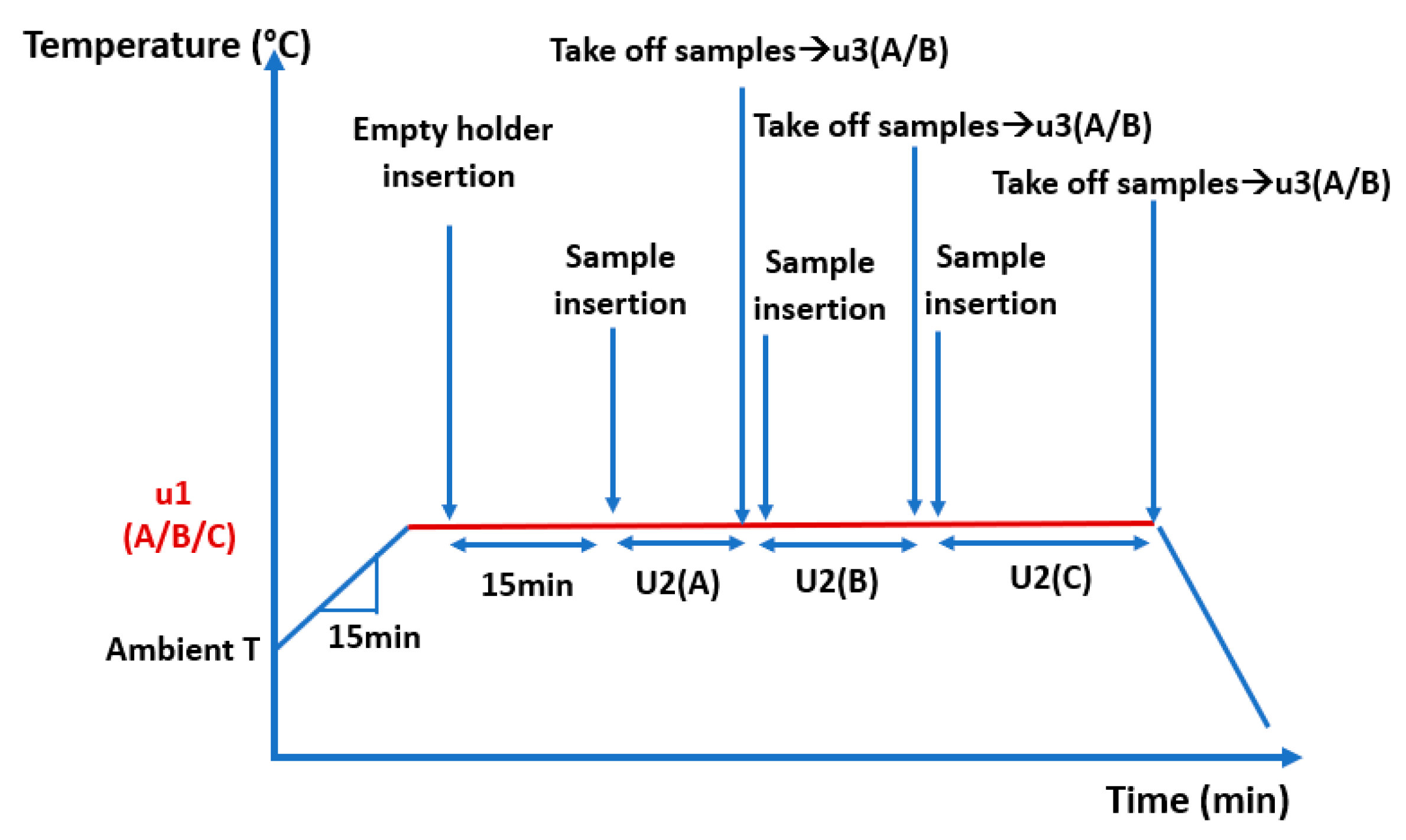


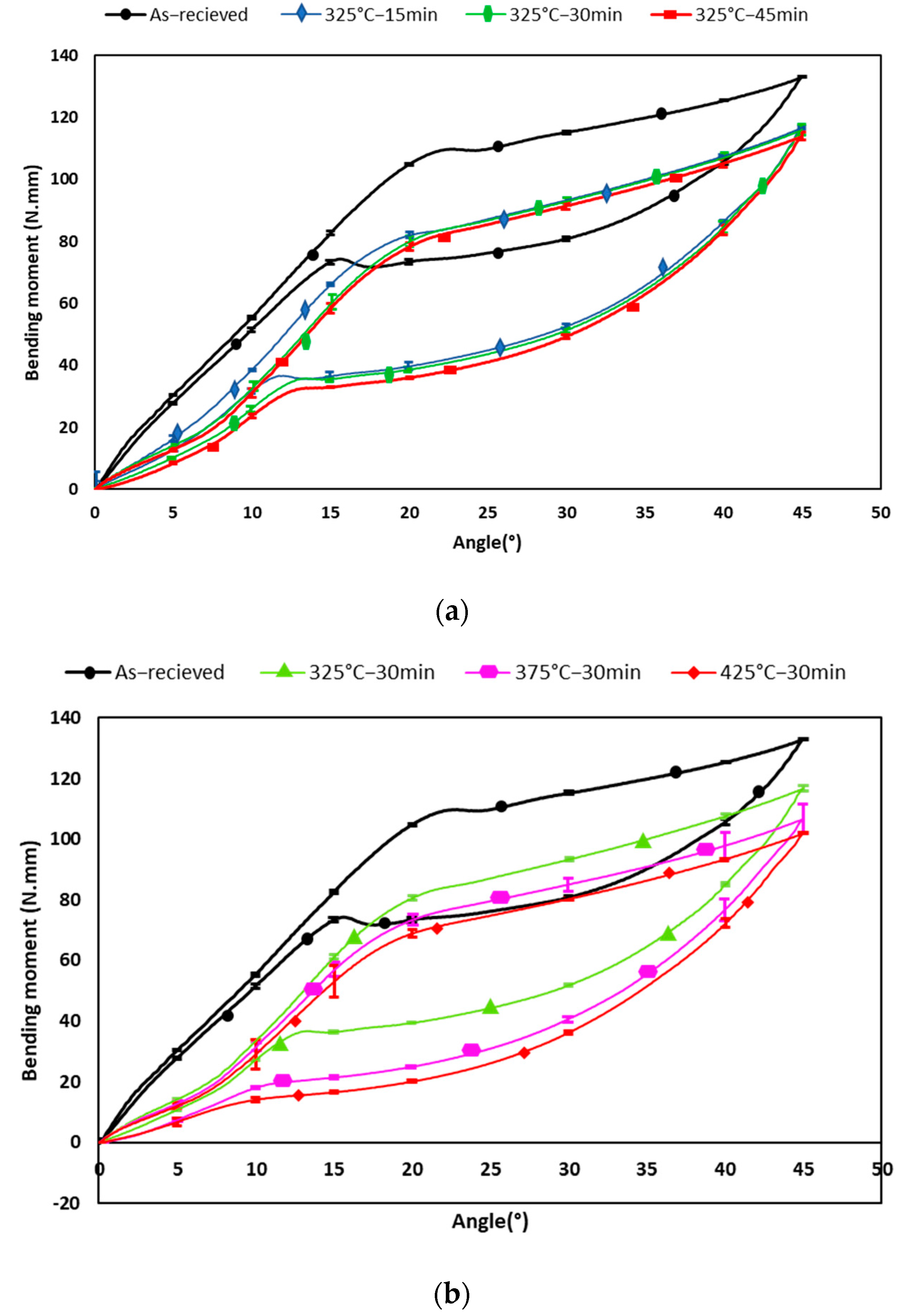

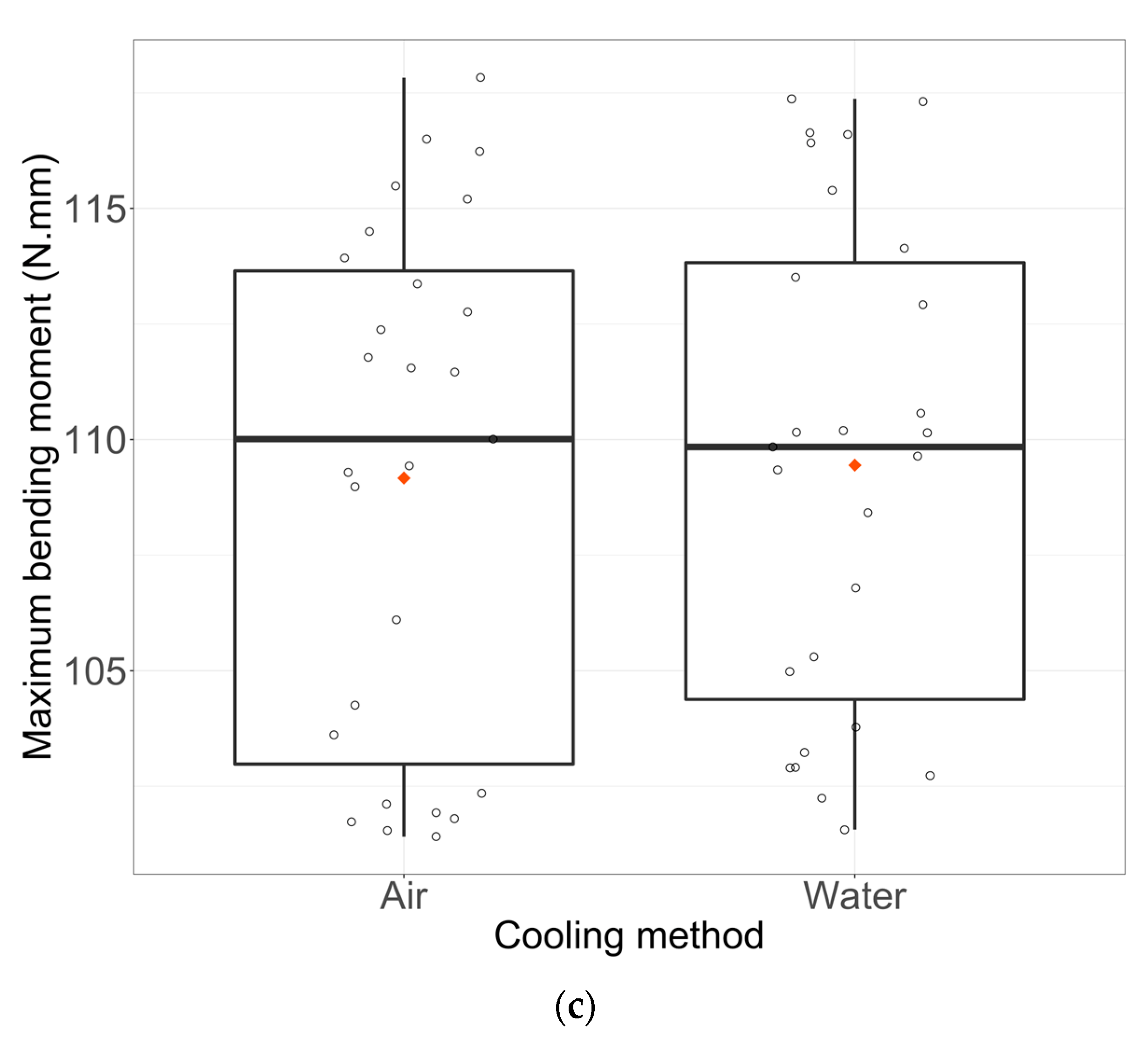
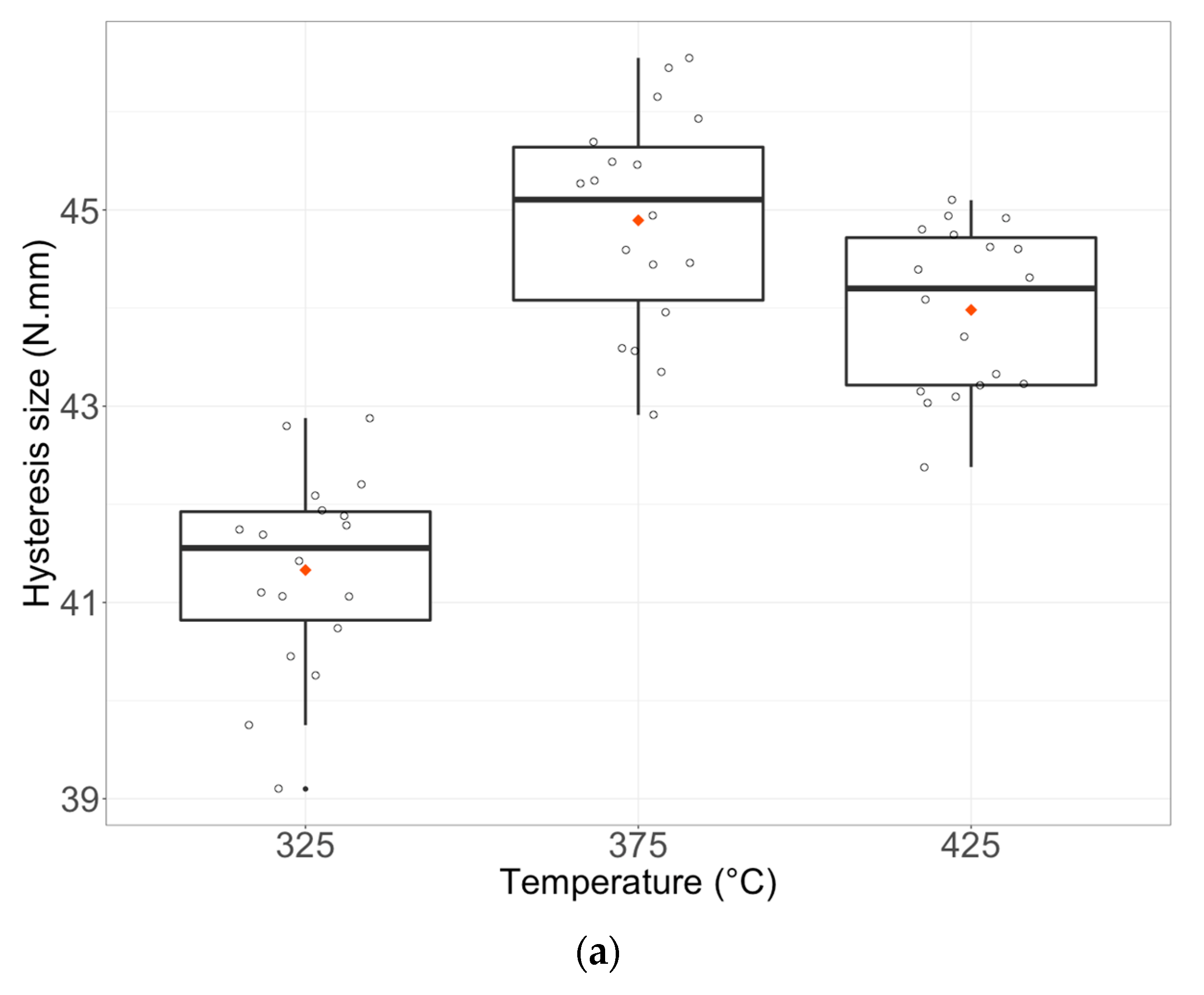
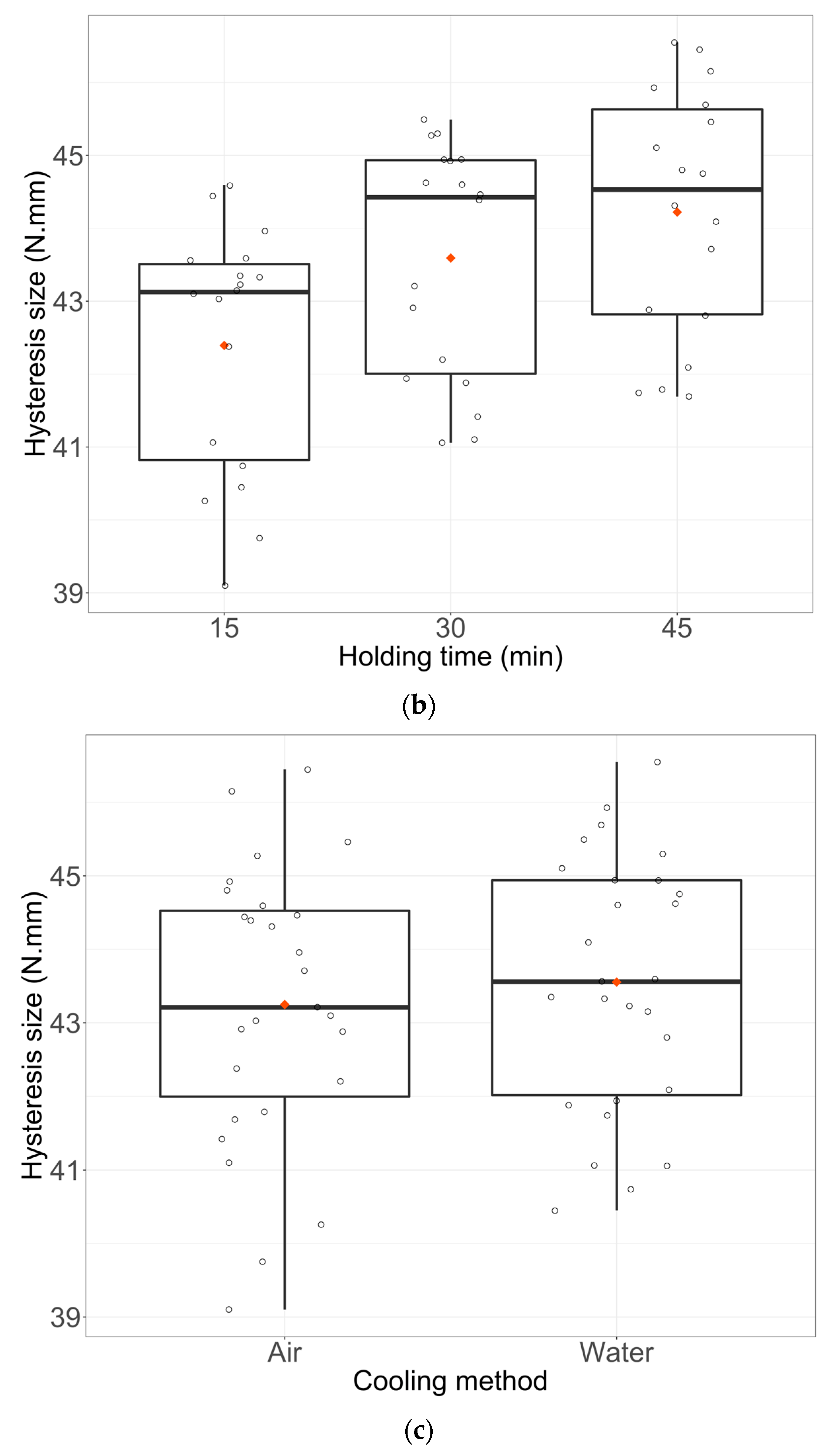
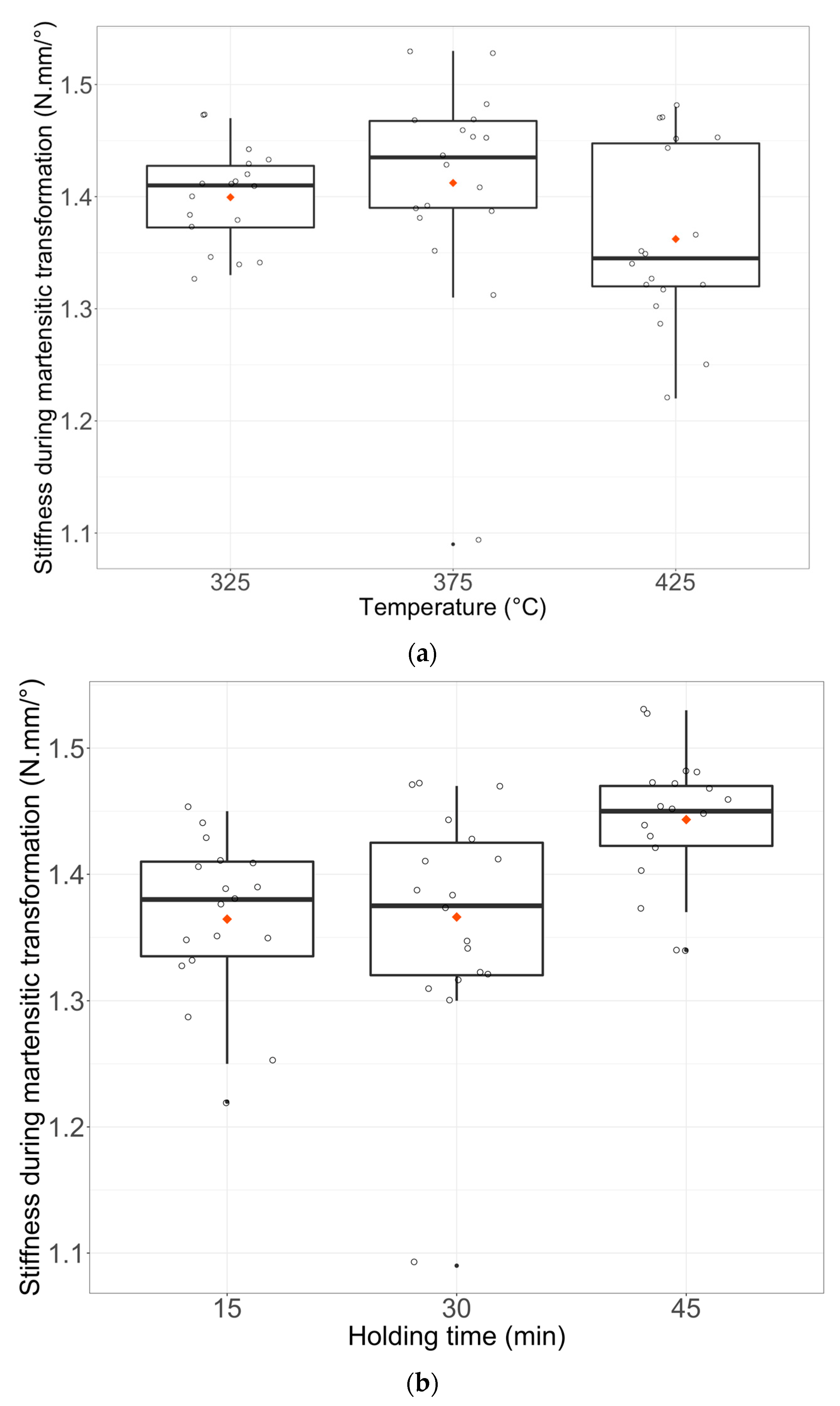
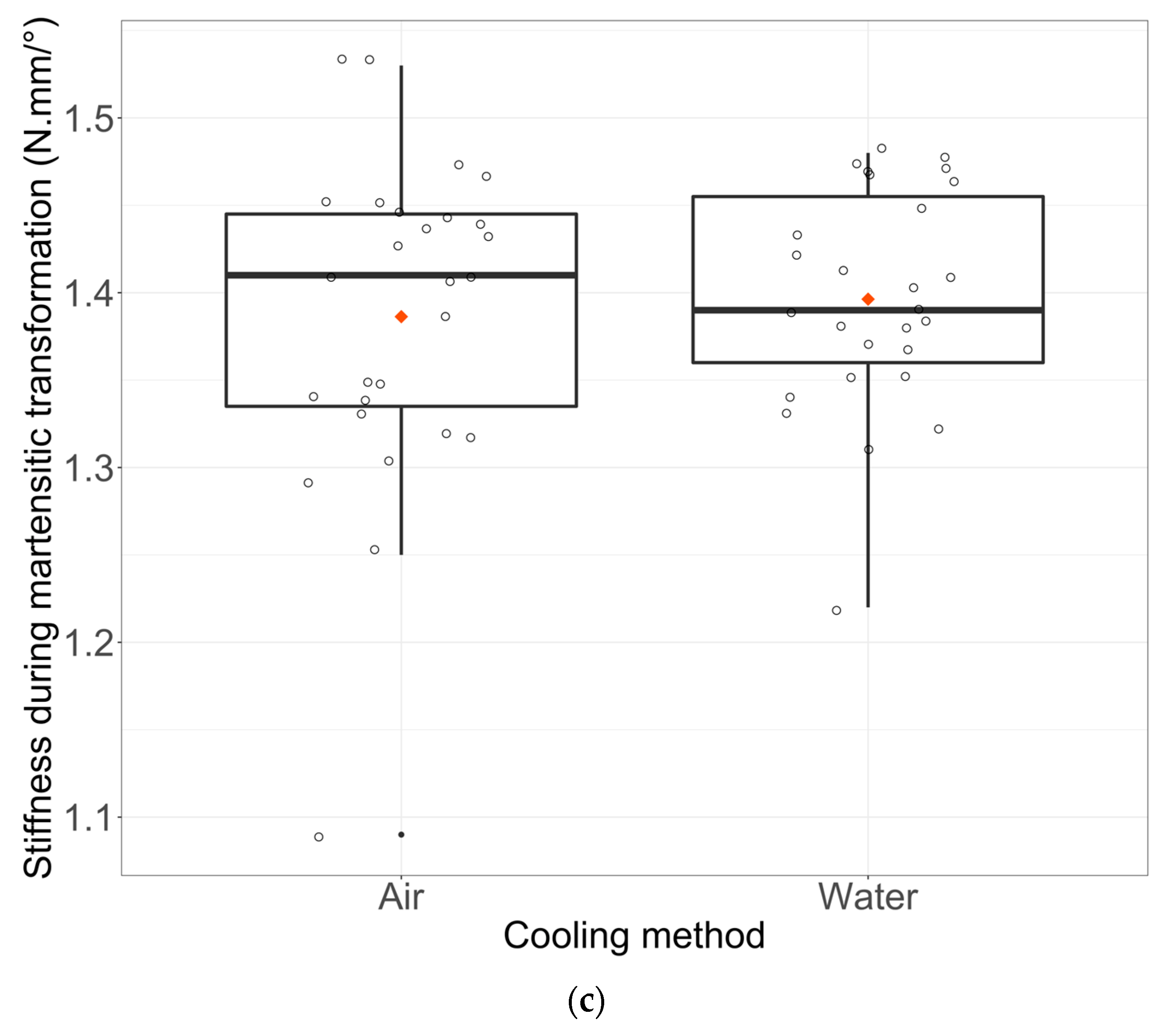
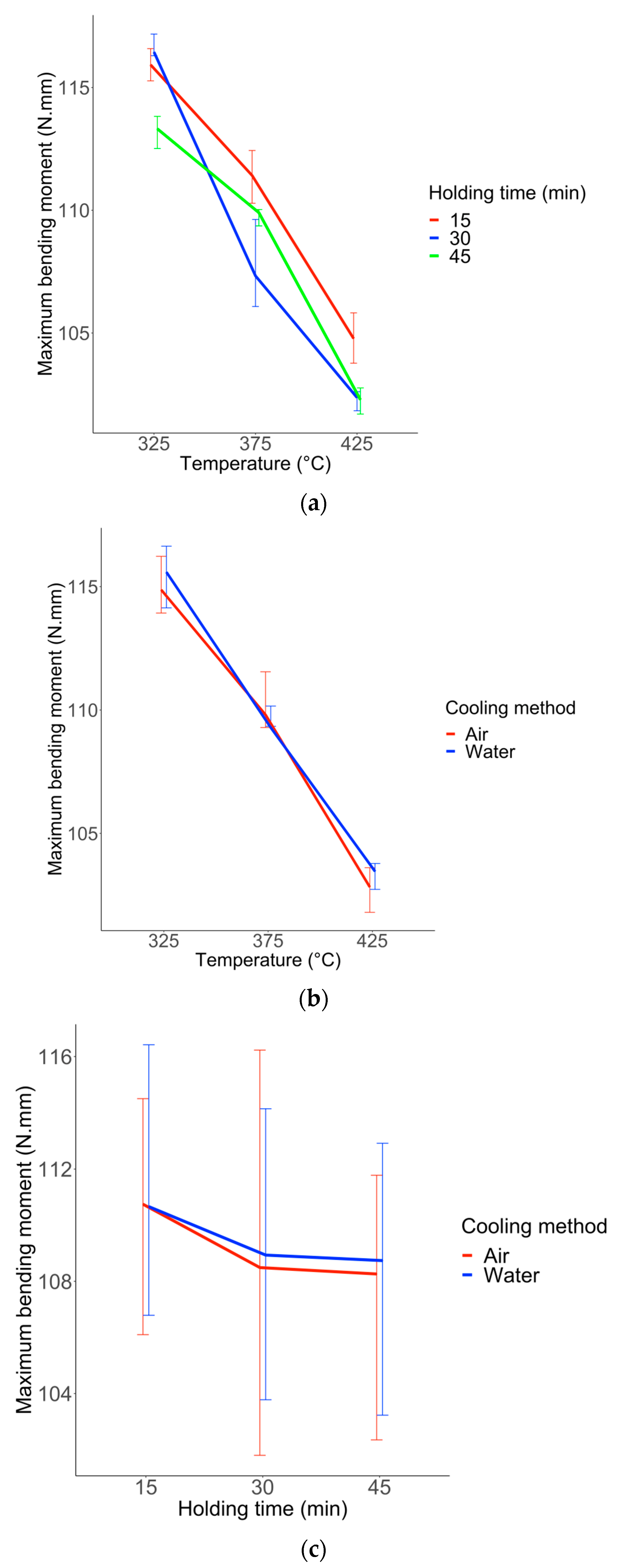
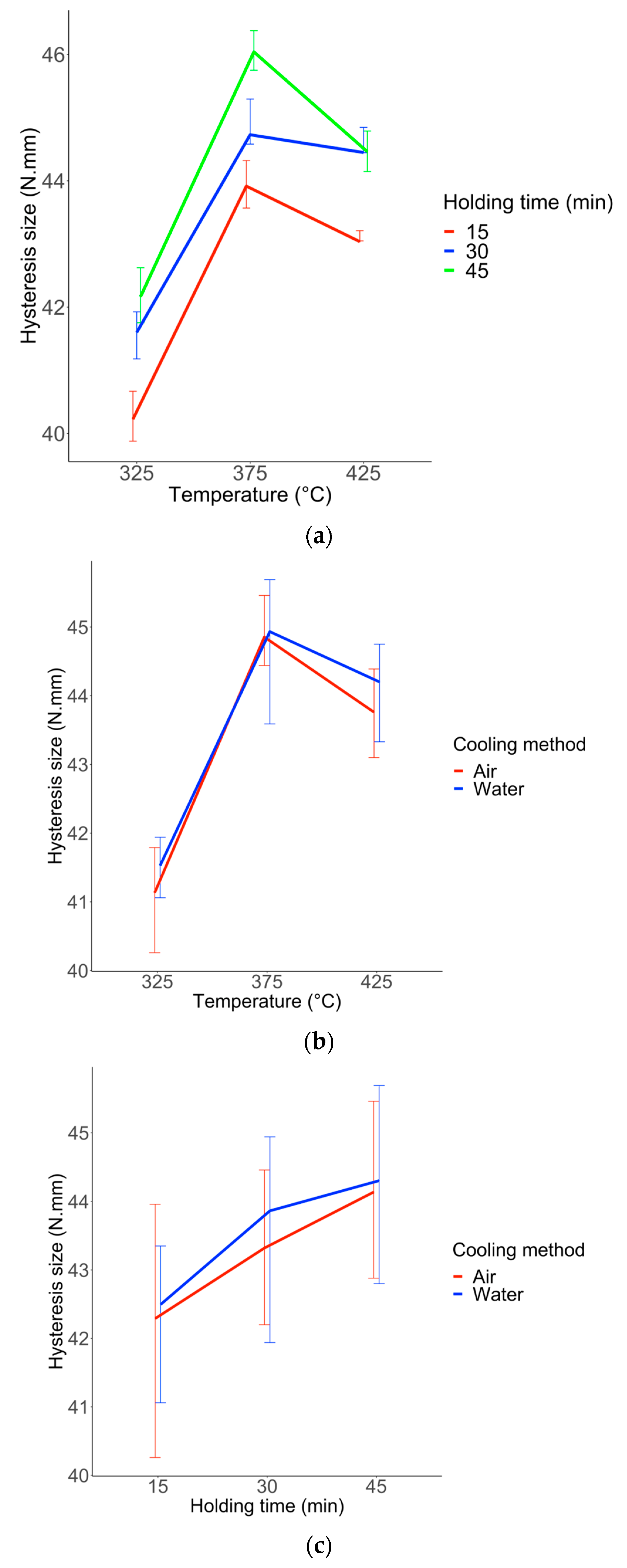
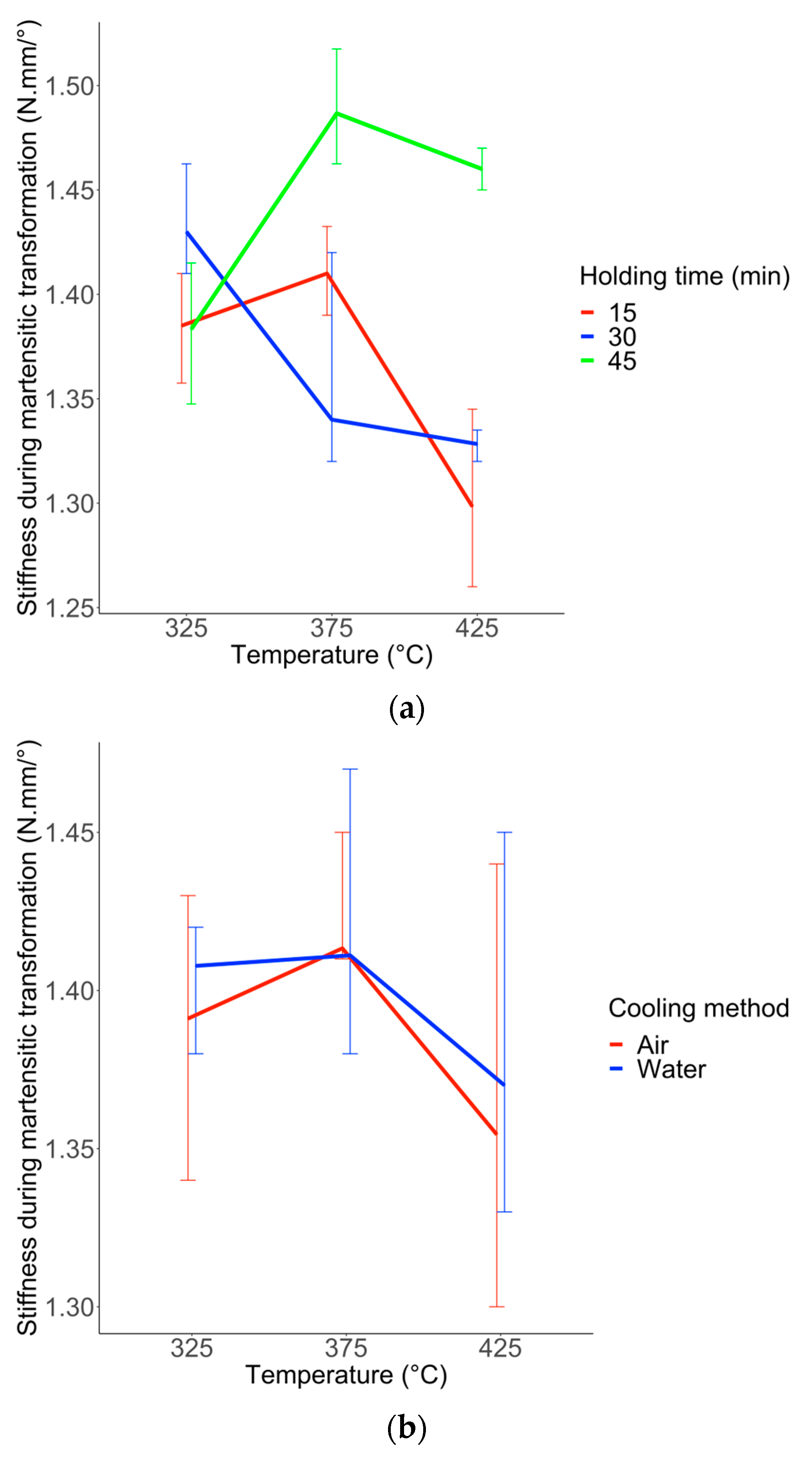

| Factors | Levels | ||
|---|---|---|---|
| A | B | C | |
| Temperature [°C] | 325 | 375 | 425 |
| Holding time [min] | 15 | 30 | 45 |
| Cooling method | Air | Water | / |
| Factors | Interaction u1/u2 | Interaction u1/u3 | Interaction u2/u3 |
|---|---|---|---|
| Y1 (Maximum bending moment) | Yes | No | No |
| Y2 (Hysteresis size) | No | No | No |
| Y3 (Transformation slope) | Yes | No | No |
| Model | R2(%) | Adjusted R2 (%) |
|---|---|---|
| Model 1 (u1 × u2 × u3) | 94.24 | 91.51 |
| Model 2 (u1 × u2 + u1 × u3 + u2 × u3) | 93.37 | 91.22 |
| Model 3 (u1 + u2 + u3) | 89.4 | 88.3 |
| Model 4 (u1 × u2) | 92.97 | 91.72 |
| Model 5 (u1 × u3) | 86.21 | 84.77 |
| Model 6 (u2 × u3) | 3.6 | −6.44 |
| Model 7 (u1) | 85.86 | 85.3 |
| Model 8 (u2) | 3.47 | −0.31 |
| Model 9 (u3) | 0.07 | −1.85 |
| Model | R2(%) | Adjusted R2 (%) |
|---|---|---|
| Model 1 (u1 × u2 × u3) | 93.82 | 90.9 |
| Model 2 (u1 × u2 + u1 × u3 + u2 × u3) | 91.97 | 89.36 |
| Model 3 (u1 + u2 + u3) | 90 | 88.96 |
| Model 4 (u1 × u2) | 90.82 | 89.19 |
| Model 5 (u1 × u3) | 72.25 | 69.36 |
| Model 6 (u2 × u3) | 18.91 | 10.46 |
| Model 7 (u1) | 71.32 | 70.19 |
| Model 8 (u2) | 17.96 | 14.74 |
| Model 9 (u3) | 0.73 | −1.18 |
| Model | R2 (%) | Adjusted R2 (%) |
|---|---|---|
| Model 1 (u1 × u2 × u3) | 62.5 | 44.8 |
| Model 2 (u1 × u2 + u1 × u3 + u2 × u3) | 58.05 | 44.42 |
| Model 3 (u1 + u2 + u3) | 30.1 | 22.81 |
| Model 4 (u1 × u2) | 56.68 | 48.98 |
| Model 5 (u1 × u3) | 8.12 | −1.45 |
| Model 6 (u2 × u3) | 23.35 | 15.36 |
| Model 7 (u1) | 7.4 | 3.77 |
| Model 8 (u2) | 22.28 | 19.24 |
| Model 9 (u3) | 0.41 | −1.5 |
Disclaimer/Publisher’s Note: The statements, opinions and data contained in all publications are solely those of the individual author(s) and contributor(s) and not of MDPI and/or the editor(s). MDPI and/or the editor(s) disclaim responsibility for any injury to people or property resulting from any ideas, methods, instructions or products referred to in the content. |
© 2023 by the authors. Licensee MDPI, Basel, Switzerland. This article is an open access article distributed under the terms and conditions of the Creative Commons Attribution (CC BY) license (https://creativecommons.org/licenses/by/4.0/).
Share and Cite
Abdelmomen, I.; Vincent, M.; Thiebaud, F.; Budzinski, J.; Bastogne, T.; Ben Zineb, T.; Engels-Deutsch, M. Experimental Analysis of the Influence of Heat Treatments on the Flexibility of NiTi Alloy for Endodontic Instruments Manufacturing. Materials 2023, 16, 3437. https://doi.org/10.3390/ma16093437
Abdelmomen I, Vincent M, Thiebaud F, Budzinski J, Bastogne T, Ben Zineb T, Engels-Deutsch M. Experimental Analysis of the Influence of Heat Treatments on the Flexibility of NiTi Alloy for Endodontic Instruments Manufacturing. Materials. 2023; 16(9):3437. https://doi.org/10.3390/ma16093437
Chicago/Turabian StyleAbdelmomen, Ihssen, Marin Vincent, Frédéric Thiebaud, Julia Budzinski, Thierry Bastogne, Tarak Ben Zineb, and Marc Engels-Deutsch. 2023. "Experimental Analysis of the Influence of Heat Treatments on the Flexibility of NiTi Alloy for Endodontic Instruments Manufacturing" Materials 16, no. 9: 3437. https://doi.org/10.3390/ma16093437
APA StyleAbdelmomen, I., Vincent, M., Thiebaud, F., Budzinski, J., Bastogne, T., Ben Zineb, T., & Engels-Deutsch, M. (2023). Experimental Analysis of the Influence of Heat Treatments on the Flexibility of NiTi Alloy for Endodontic Instruments Manufacturing. Materials, 16(9), 3437. https://doi.org/10.3390/ma16093437







